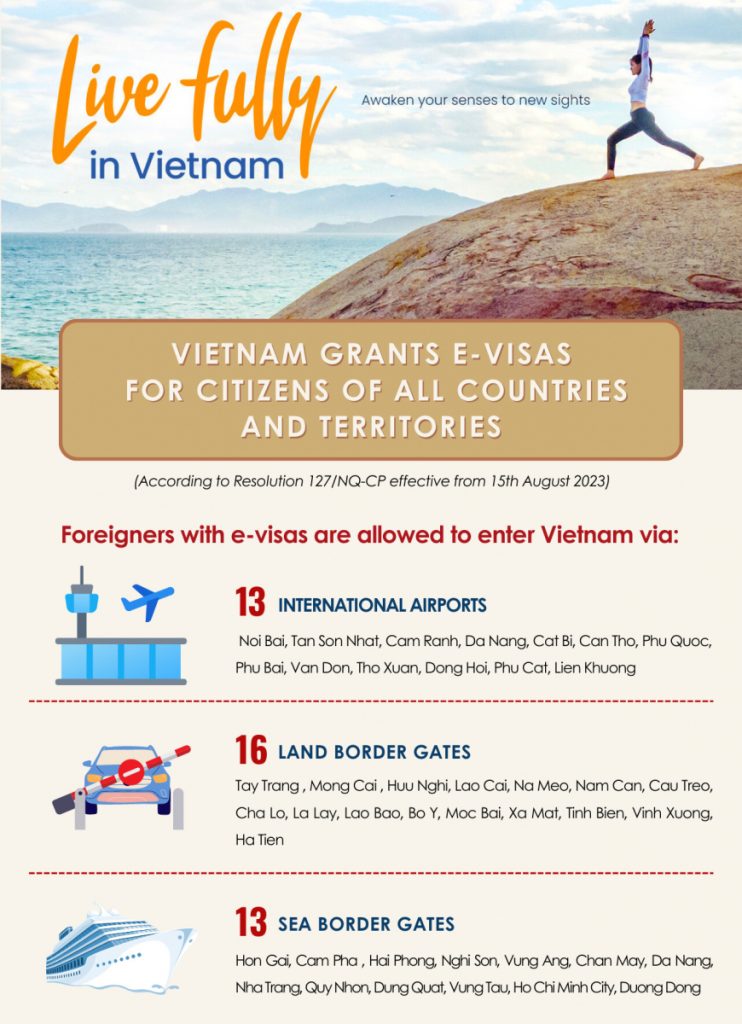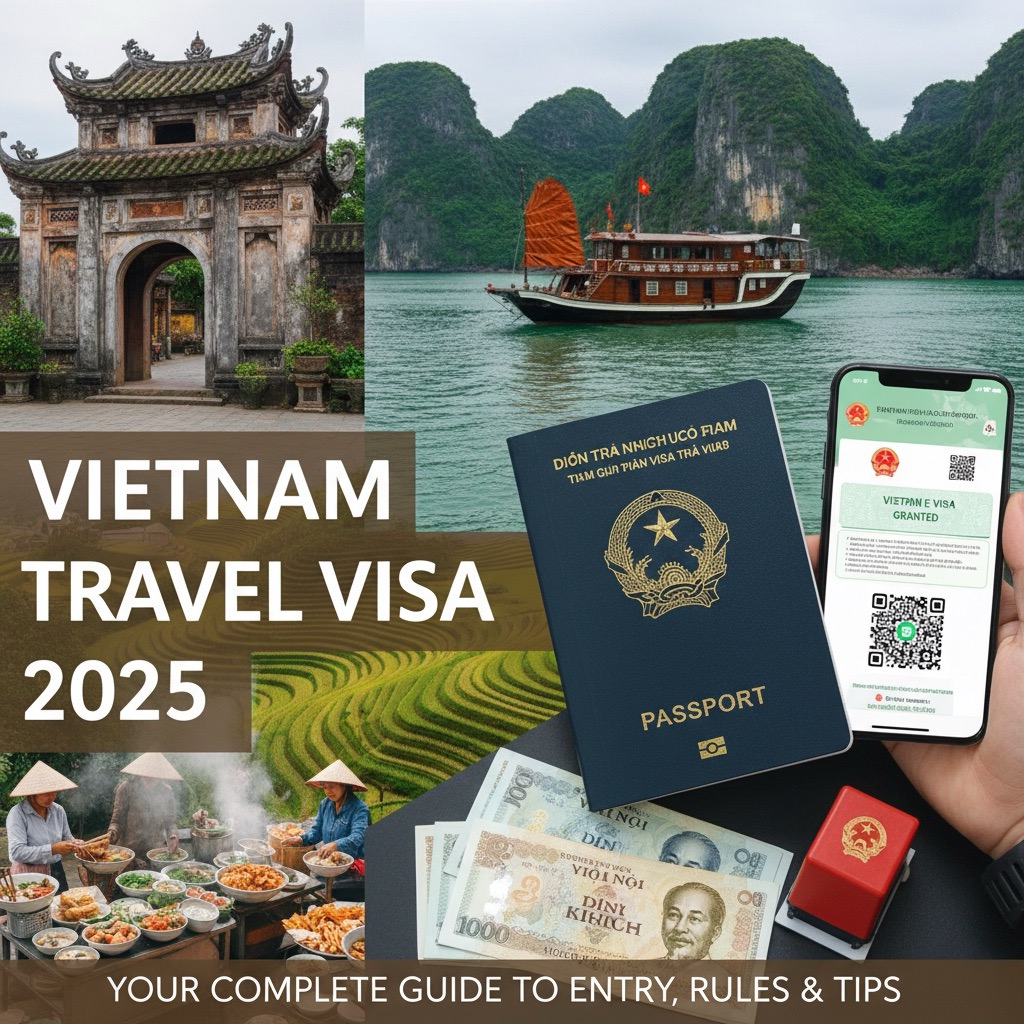Vietnam is a magnet for travelers: from the limestone karsts of Ha Long Bay to the lanterned charm of Hoi An, from the bustling streets of Hanoi and Ho Chi Minh to the rural beauty of the Mekong Delta. But as easy as it is to fall in love with Vietnam, navigating its visa rules can be confusing, especially with recent changes in 2025.
This guide walks you through everything: who needs a visa, how to apply (e-visa, visa on arrival, embassy visa), recent policy updates, fees, extension rules, pitfalls to avoid, and what to expect on arrival. Whether you're coming from, the US, Europe, India or elsewhere, this is your go-to reference for Vietnam travel visa 2025.

Vietnam’s Visa Policy Landscape (2025 Updates)
E-Visa for All Countries
Since August 15, 2023, Vietnam officially offers e-visas to citizens of all countries and territories, with stays of up to 90 days, and in many cases multiple entries permitted.
This is a major shift: earlier, many nationalities had to go via embassies or VOA only.
Expanded Visa Exemptions (2025)
Vietnam continues to adjust its visa waiver policies to boost tourism. Some of the key developments in 2025:
- From March 1 to December 31, 2025, citizens of Poland, the Czech Republic, and Switzerland, when traveling via organized tour packages, can enter visa-free for up to 45 days.
- From August 15, 2025 to August 14, 2028, a general visa-free regime is in effect for certain countries, allowing stays up to 45 days (for tourists) if entry conditions are met.
- Decree No. 221/2025 (August 8, 2025) introduces visa exemption for some special categories (priority visitors for socio-economic development).
Note: Some earlier exemptions (e.g. for Poland/Czech/Switzerland under Government Resolution 11) may expire or be superseded after August 15, 2025.
Thus, always check the current status just before travel (especially if your nationality is among the exempted ones).
Summary: Who needs a visa in 2025?
Visa-free travelers: only citizens of certain nations under the visa exemption scheme (for 45 days) can travel without a visa, depending on timing and conditions.
Below is the full list of 25 countries +Kazakhstan that are exempted from visa requirement:
Brunei, Myanmar, Belarus, Denmark, Finland, France, Germany, Italy, Japan, Norway, Russia, South Korea, Spain, Sweden, The UK, The Philippines, Cambodia, Indonesia, Kyrgyzstan, Laos, Malaysia, Singapore, Thailand, Chile, Panama.
Other travelers: most foreign nationals must obtain either an e-visa or visa in advance (or use VOA in some cases).
Types of Vietnam Visas & Entry Methods
Here is a breakdown of common visa methods and types:
| Visa / Method | Use Case | Stay Duration | Entries | Notes |
|---|---|---|---|---|
| E-Visa | Most tourists / general visitors | Up to 90 days | Single or multiple (depending on issuance) | Best all-round option in 2025 Know more |
| Visa on Arrival (VOA) | For travelers entering by air who prefer to pick up visa at airport | Up to 30 days (tourist) / longer for business | Single / multiple (depending on letter) | You must arrange a visa approval letter in advance. Know more |
| Embassy / Consulate Visa (Sticker Visa) | Travelers via land borders or prefer to have visa beforehand | 1 to 3 months, possibly longer | Single / multiple | Traditional method, useful for non-air entry, or when VOA isn't available |
| Visa Exemption / Visa-free Entry | Nationals of certain countries under special regimes | Typically up to 45 days | Single (in most cases) | Only for citizens of exempt nations meeting criteria. |
| Special / Priority Exemptions (2025 Decree) | For priority groups (investors, professionals) | May vary | May vary | Under Decree No. 221/2025 as of August 2025. Know More |
| Golden Visa / Long-term Visa (Proposal) | For long-term investors, professionals, digital nomads | 5–10 years or more | Multiple | In 2025, reports suggest Vietnam is introducing a Golden Visa program. |
How to Apply for a Vietnam E-Visa (2025 Step-by-Step)
- This is the most traveler-friendly option in 2025 for many nationalities.
- Go to the official Vietnam National Electronic Visa System (evisa.gov.vn).
- Fill in required information: personal details, passport info, intended dates, port of entry/exit, etc.
- Upload a recent photo (4×6 cm or as specified) and scanned passport bio page.
- Pay the visa fee online (via credit/debit / bank transfer).
- Wait for processing (usually takes a few working days).
- Check approval status using registration code / email.
- Once approved, download and print your e-visa.
- At arrival, present your passport + printed e-visa and enter via designated ports.
Notes / Tips
- Once issued, you cannot change the personal information, stay dates, or port details.
- Keep your registration code / application number to check status.
- Even if your e-visa is digital, always carry a printed copy when arriving. Immigration may demand it.
- If your visa is for 30 days or shorter, extension or renewal is possible from within Vietnam through a local agency or immigration office (with a guarantor).
💡 Pro Tip: Apply at least 2 weeks before your trip to avoid delays.
You may need or be interested in
Documents & Requirements
Here is a typical checklist of what you’ll need, depending on visa method and nationality (these are not exhaustive — always verify with the embassy or e-visa portal):
| Item | E-Visa / VOA / Embassy | Notes |
|---|---|---|
| Valid passport | Required | Passport should be valid for at least 6 months beyond your date of arrival. |
| Passport’s blank pages | Required | At least 2 consecutive blank pages for the visa stamp (for VOA or sticker) |
| Completed visa application form | Required | For embassy or VOA (the e-visa portal has built-in forms) |
| Recent passport-sized photo (4×6 cm) | Required | White / plain background; digital upload for e-visa, physical copy for VOA / embassy |
| Flight ticket / proof of exit | Sometimes | May be required to show onward travel |
| Hotel / accommodation bookings | Sometimes | Important especially for embassy applications |
| Bank statement / proof of funds | Sometimes | Especially for embassy visa applications. |
| For VOA: approval letter | Required | Must be obtained before departure |
| Stamping fee (cash) | For VOA / embassy | Usually in USD |
| Entry / Exit form | For VOA / arrival | Supplied at airport or immigration counter |
| Supporting documents (if any) | Business permit, invitation letter, sponsorship, etc. | For business visas or special cases |
Vietnam Visa Fees (2025)
| Visa Type | Duration | Fee (Approx.) |
|---|---|---|
| E-Visa (Single) | 90 days | $25 USD |
| E-Visa (Multiple) | 90 days | $50 USD |
| Visa on Arrival | 1–3 months | $25 + agency fee |
| Embassy Visa | Varies | $60–120 USD |
Entry & Exit Points / Border Rules

Even with a valid visa or e-visa, your entry and exit must be via designated ports that accept visa or e-visa entries. Here’s what to keep in mind:
- E-visa allows entry and exit via certain airports, seaports, and land border gates listed on the official portal.
- Some land border crossings may not accept e-visas or VOA — in such cases, you must use the embassy visa route.
- Major airports accepting visa / stamping include: Hanoi (Noi Bai), Ho Chi Minh City (Tan Son Nhat), Da Nang, Cam Ranh, Phu Quoc, etc.
- Land border gates such as Mong Cai, Lao Cai, Huu Nghi, Moc Bai (Vietnam–Cambodia) often serve tourists, but only if your visa type supports land entry.
- When filling your visa / e-visa application, you must specify your intended port of entry and exit. Mistakes may lead to denial at arrival.
- If you plan a cruise or seaport entry, confirm whether e-visa or VOA is accepted at that seaport (not always guaranteed).
FAQs on Vietnam Travel Visa 2025
Q. Can I extend my Vietnam e-visa in 2025?
Yes, but you’ll need to visit an immigration office in Vietnam or use a local travel agency to process extensions.
Q. Is the Vietnam e-visa valid for multiple entries?
Yes, Vietnam now offers both single-entry and multiple-entry e-visas.
Q. Can I enter Vietnam by land or sea with an e-visa?
Yes, e-visas are accepted at major airports, land borders, and seaports.
Q. How does Vietnam e-visa look?
Here is a sample of the Vietnam e-visa:

You will receive the Vietnam e-visa as an electronic PDF document linked to your passport number. It includes your personal information, passport number, visa type, duration of stay and validity period.
Q: What if I miss my exit date?
A: Trying to overstay without extension is risky. You may face fines, deportation, or bans. Always try to extend your visa legally before it expires.
Q: Does Vietnam have a Golden Visa now?
A: As of mid-2025, the Golden Visa program is proposed and being planned; not fully operational for all applicants.
Common Pitfalls & Travel Tips
- Apply early — don’t leave visa process to last minute
- Print your e-visa even if it is digital
- Double-check your passport details, name spellings, date of birth, and passport expiry
- Confirm that your port of entry/exit is accepted for your visa type
- Be cautious with VOA service providers — avoid scam or overpriced agencies
- Carry USD cash (or required currency) for stamping fees on arrival
- Check Vietnam’s public holidays — embassy / immigration offices may be closed or delayed
- Make sure your passport has enough blank pages
- If traveling via land borders, ensure your visa permits land entry
- Always keep photocopies or digital backups of passport, visa, approval letters
- If planning onward travel (e.g. multi-country trips), ensure your exit and onward flights are aligned with allowed stay periods
Final Thoughts
Getting your Vietnam travel visa in 2025 is easier than ever. With the new 90-day e-visa and broader eligibility, exploring Vietnam has become much more convenient for global travelers.
Whether you’re backpacking through Hanoi’s Old Quarter, cruising the Mekong Delta, or relaxing on Phu Quoc Island, having the right visa ensures a stress-free adventure.
